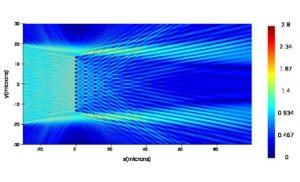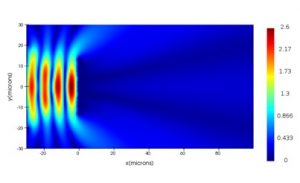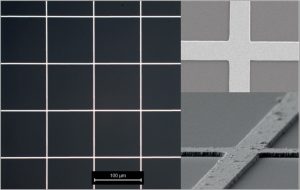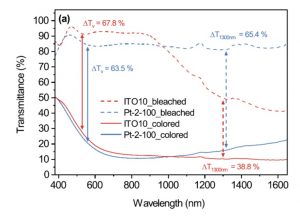Conventional selective low-e coatings for windows of residential buildings have a cut-off frequency in the near infrared spectral region NIR, limiting the resulting solar heat gain coefficient to g ≈ 0.5. By structuring the coating into micro-/nanomeshes, the selectivity shall be enhanced and higher solar heat gains shall be achieved. The resulting increase in solar heat gains will lead to energy savings in heating in the residential sector.
In addition to this, metal nanomeshes will also allow to replace the transparent conductive oxide layer in electrochromic windows, reducing the needs for indium, and leading to higher switching speed and switching homogeneity by an improved lateral charge transport.
All switchable window technologies are based on transparent conductive electrodes, which are currently made from transparent conductive oxides (TCOs). Indium tin oxide (ITO) belongs to the TCOs with the highest performance regarding the trade-off between transparency and electrical conductivity. With the widespread use of screen and display technologies, and the growing market of photovoltaics, the demand of indium is constantly increasing. However, indium is one of the scarcer elements, at least in terms of average abundance in the Earth’s crust. Metallic micro-/nanomeshes are an interesting emerging alternative to transparent conductive oxides, because the micro-nanomeshes combine high transparency with electrical conductivity.
For short-wavelength radiation in the spectral range of solar radiation (VIS-NIR), the openings are comparatively large to the wavelength, and the electromagnetic wave is transmitted. Therefore, the nanomesh is transparent.
For long-wavelength radiation in the spectral range of thermal radiation, the dimensions of the openings are comparable to the wavelength, and the electromagnetic wave is reflected. Therefore, the nanomesh is an infrared-reflector and the surface with the nanomesh has a low thermal emissivity (see Fig. 1).
Electricity is conducted in the nanowires of the mesh. Therefore, the nanomesh can be used as transparent electrode. We showed that transparent conductive metallic micro-/nanomesh electrodes, which allow for a transmittance switch in the full spectral range of solar radiation, are highly promising candidates for the replacement of indium tin oxide in electrochromic devices [FLE 2023] (see Fig. 2-3).
Approaches for the fabrication of metallic micro-nanomeshes are laser engraving, self-assembly and UV/electron beam lithographies. Our findings might also have significant impact in the fields of silicon and perovskite solar cells, energy-efficient lighting, flat screens and displays.
PhD thesis in this domain:
J. Fleury, title of PhD thesis: Transparent structured conductive coating for applications in smart windows, EPFL PhD thesis No. 10029 (2023). Thesis director Prof. J.-L. Scartezzini, codirector A. Schüler
References
[FLE2023] Fleury, J., Burnier, L., Lagier, M., Shukla, S., Manwani K., Panda, E., Schüler, A., Electrochromic device with hierarchical metal mesh electrodes: Transmittance switching in the full spectral range of solar radiation, Solar Energy Materials and Solar Cells 257 (2023) 112345 https://doi.org/10.1016/j.solmat.2023.112345
[MEI2006] Mikrostrukturierte Meatallschichten auf Glas, PhD thesis Bayerische Julius-Maximilians-Universität Würzburg


Fig. 1: FDTD simulations of electromagnetic wave transmission through a metallic mesh with a periodicity of 1’875 nm and mesh openings of 875 nm [PhD thesis J. Fleury]. The colours indicate the relative intensity of the electrical component for an electromagnetic wave with a wavelength of
Top: 550 nm (partially transmitted)
Bottom: 15 mm (entirely reflected).

Fig. 2: (a) Microscope and (b, c) SEM images of a metal mesh with a periodicity (p) of 100 mm, a line width (w) of 2 mm and a thickness (t) of 300 nm. The metal mesh was produced by means of UV lithography. [FLE2023]

Fig. 3: Electrochromic properties of the WO3 cathode comparing ITO and the metal mesh: Transmittance spectra in colored and bleached states. In contrast to the ITO electrode, the conductive transparent nanomesh allows good transmission control in a large spectral range of solar radiation (blue dashed and solid lines).